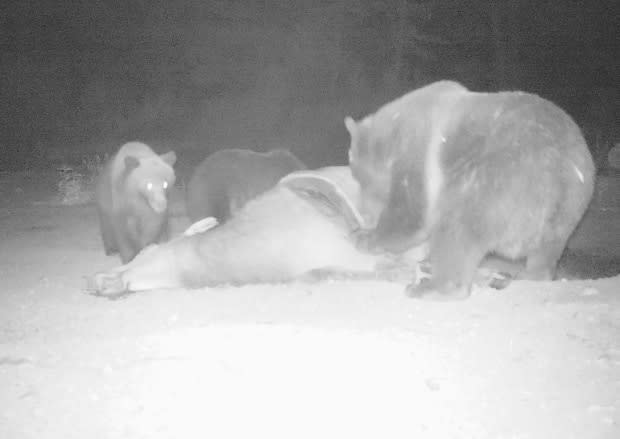How grizzly bears have learned to live with humans
Grizzly bears in Canada have developed an adaptation behaviour that lets them continue living near humans yet reduce their interaction with us, according to decades of research into their behaviour.
In areas where bears and humans coexist, there are often policies in place to protect bear populations while safe-guarding people's lives. But it turns out the bears are also helping their own cause.
A team of researchers from B.C. and Alberta pooled data on the movements, habitat use and mortality rates of 2,669 grizzly bears over 41 years to examine how they survived when living in or near human-dominated areas.
The researchers found that even as humans encroached further and further into the animals' habitats, the bears didn't necessarily shy away from people, but instead gradually shifted their behaviour to become more active at night, when they would be less likely to come into contact with them.
The data was compiled from an area of 378,191 square kilometres predominantly in B.C., which has an estimated 15,000 grizzlies — more than half of Canada's grizzly bear population.
The research was published Monday in Proceedings of the National Academy of Sciences.
Better survival by becoming nocturnal
Typically, bears in the wilderness spend about half their time in daylight and half under cover of darkness, said study co-author Clayton T. Lamb, who is affiliated with the University of Alberta, the University of British Columbia and the University of Montana.
But by increasing their "nocturnality" by two to three per cent each year, bears living in "coexistence landscapes" — in proximity to people — also increased their survival rate by two to three per cent per year. This led the researchers to conclude that the shift to more nighttime activity was induced by humans.
The older the bears got, the more nocturnal they became, starting from the age of three onward, to the point where the bears observed in the study reached at least 60 per cent nocturnality, and most of them 70 per cent or more.
Younger bears and those that didn't adopt the behaviour didn't do as well.
"If you could learn to live there, you could do OK," Lamb said in an interview. "A lot of bears don't switch fast enough and they end up dying."

Grizzlies are "integral" to maintaining a healthy ecosystem, the B.C. government says. But their survival is at risk, according to both the provincial Conservation Data Centre and the federal Committee on the Status of Endangered Wildlife in Canada (COSEWIC).
The biggest threat to bears? People.
B.C. banned grizzly bear hunting in 2017. In the decades prior to that, the province's statistics found an average of 340 grizzly bears died from "human causes" each year — most killed by hunters, but about 30 were killed by animal control as a result of conflicts with humans.
Better for bears, better for humans
This shift to nocturnal behaviour is not only better for the bears, it's better for humans, because it reduced the number of conflicts between the species, the study said.
Looking at the records of conflicts with 45 individual bears who were fitted with GPS collars, the researchers found there was about a 71 per cent lower chance of conflict with one of them at least once a year if the bears were more active at night than during the day.
"There's more conflict where there's more people, obviously," Lamb said. "But bears that were more nocturnal were always in less conflict, regardless of how close they were to people.
"Bears are helping to shape that landscape to benefit themselves."
Nonetheless, bears are still on the losing side of the equation.
Even though a majority of adult female bears in the area have become more nocturnal and are breeding successfully, they are dying in numbers too high to maintain their population.
For every bear that becomes a successful "coexister," 29 die prematurely, the research found. They have to rely on "immigrant" bears from nearby wilderness areas to keep thriving.
This isn't the first time animals have been observed shifting their schedules. A 2018 analysis of dozens of studies covering 62 species, including brown and black bears, found animals increased their nocturnality "in response to human disturbance."
But Lamb said the four decades of research on bears brings the whole picture into focus: the extent of the risk they face from living near people, the adaptation that helps them survive and the need for "demographic rescue" via bear immigration to sustain their numbers.
"The next steps in all this research is really the applied aspect — what can we do with this information to make the landscape work better for people and carnivores," Lamb said.

